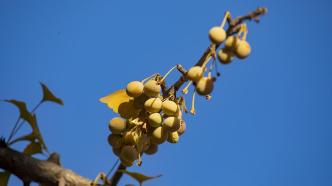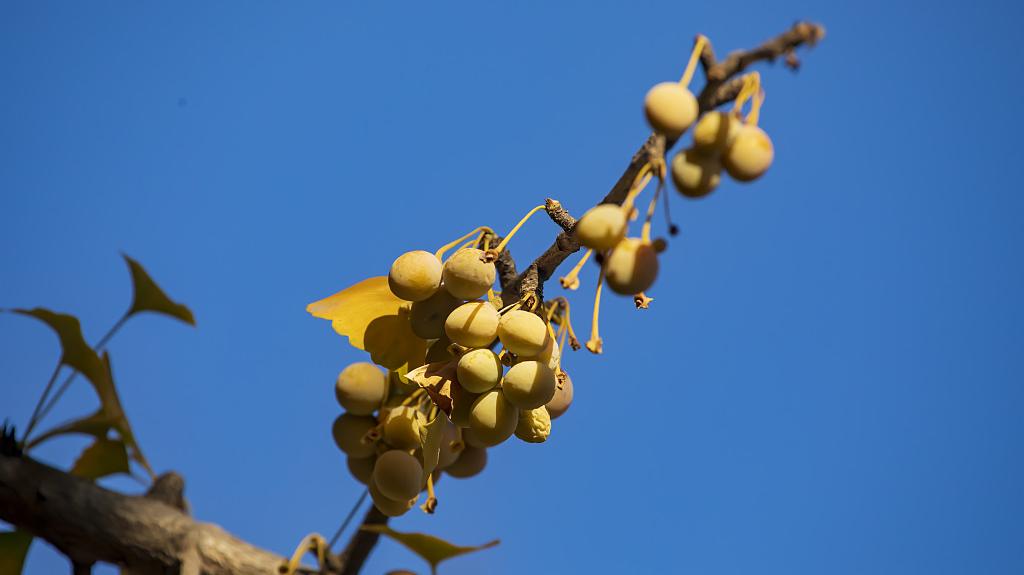

The fruit of the ginkgo tree. Visual China Data Map
In autumn, the golden ginkgo fruit is so beautiful, but they are also a "treasure" in the eyes of scientists.
Cheng Qunfeng's team, a professor at the School of Chemistry, Beihang University, found that the stone cells of ginkgo husk have a unique "interlocking" structure, which provides inspiration for the future preparation of complex biomimetic nanocomposites with isotropic mechanical properties. Relevant research results were recently published online in the Proceedings of the National Academy of Sciences.
"hard" is relative
Natural materials such as abalone shells, bones, wood, etc. are generally hard and are considered to have excellent mechanical properties, especially fracture toughness. The reason is that during the fracture process, the cracks tend to deflect or bridge, and the resistance to propagation in the material is greater.
"For example, two sheets of A4 paper stacked together can be easily separated. If two sheets of paper are glued together or stapled together, it is difficult to separate them. The resistance in the middle includes bridging. Force." Cheng Qunfeng, the corresponding author of the paper, told the Chinese Journal of Science.
However, the stiffness of these natural materials is relative, with high fracture toughness in only one direction.
The same is often true of carbon fiber composites used in aerospace equipment. In fact, metal materials have high fracture toughness in all directions, but their defects such as high density are also obvious.
"Is there any isotropic high-toughness material like metal in natural materials?" Cheng Qunfeng said. They chose plant husks because plant seed husks can protect embryos from damage. As a natural and "perfect" barrier, it is "hard and soft".
Studies have shown that the shell structure is multi-layered, including organs, tissues, cells, sub-cells, fibers, etc., and the strong mechanical properties are related to this structure. For example, stone cells in walnut shells and pistachio shells have jagged edges, known as "three-dimensional puzzle stone cells." As another example, Brazil nuts contain a lot of fiber in their microstructure.
"Although researchers are aware of the multi-level structure of nut shells, the overall research has only analyzed the relationship between the microstructure and properties of nut shells at a single scale (such as at the cell level, fiber level, etc.). The scale three-dimensional microstructure and the relationship between structure and performance need to be further studied.” Cheng Qunfeng said.
The unique "interlocking" structure of ginkgo husk
The researchers tried many plant husks, and finally found that ginkgo husk might be the ideal material, which is an exciting result. The ginkgo trees that can be seen everywhere in Beijing also provided them with rich research raw materials.
The internal microstructure of natural materials determines their excellent mechanical properties. The researchers first analyzed the internal microstructure of ginkgo husk in detail, and found that it has a typical multi-level micro-nano composite structure, especially the stone cells of ginkgo husk have a unique "interlocking" structure.
The "interlock" structure is like a screw-nut fit.
Cheng Qunfeng introduced that the ginkgo shell looks like a spindle, and is tightly bound together by a large number of polygonal stone cells with thick cell walls. In the inner secondary wall of the stone cells are elongated channels with a radius of about 1.2 microns, the pits. A pit is a hollow tubular structure. The pits extend from the cavity in the middle of the cell to the intercellular layer, forming "pit pairs" with the pits of adjacent stone cells. The fibers are oriented along the radial direction of the pit and wound around the pit. This unique "pit pair" structure "interlocks" adjacent cell walls together, which is called "screw interlocking structure".
Through the in-situ testing system combined with the scanning electron microscope and stretching table, the researchers found that there is also a unique pit-induced crack propagation mechanism in the ginkgo shell. Stone cells, or directly through the stone cells along the pits so that the crack enters its central cavity.
"The unique structure of ginkgo shell makes its fracture toughness basically the same when cracks propagate in all directions." Cheng Qunfeng said that compared with anisotropic materials such as wood whose fracture toughness varies by 10 to 20 times in different directions, ginkgo fruit The shell shows isotropic features. At the same time, there are crack deflection, bridging, and fiber pull-out mechanisms for crack propagation in all four directions.
In addition, the study also found that the highest fracture toughness of ginkgo is even close to that of abalone shell, insect skin and other artificial shell materials. This unique structure provides new bionic inspiration for scientists to design isotropic bulk materials.
10 years of grinding new discoveries
This research has gone through nearly 10 years, and has gone through 3 doctoral students.
In 2010, under the recommendation of Jiang Lei, Academician of the Chinese Academy of Sciences and Dean of the School of Chemistry of Beihang University, Cheng Qunfeng joined the School of Chemistry and engaged in the research of polymer nanocomposites. In 2013, while Cheng Qunfeng was attending an academic conference in the United States, Jiang Lei, who has always emphasized the research of "learning from nature", noticed the nut shell and sent him a message: "You can consider the mechanical properties of the natural shell."
After returning to China, Cheng Qunfeng quickly organized students to systematically investigate many natural nutshell materials, and made a lot of comparisons with existing natural structural materials. The mechanical properties are excellent, but not ideal in other directions.
Nature is a harmonious system. Since there are anisotropic natural materials, there must also be isotropic natural materials. Cheng Qunfeng rekindled his confidence and systematically characterized the microstructure and isotropic fracture toughness of ginkgo husks. The results made him very excited.
In 2019, Cheng Qunfeng's team completed the thesis. However, the reviewers asked tough questions because so little attention has been paid to the interdisciplinary field of plants and materials. To this end, the team went through supplementary experiments and repeated revisions, and after three years, the paper was finally published.
Cheng Qunfeng said that the current research is still in the discovery of the intrinsic properties and structures of natural materials. In the next step, they will consider using the bionic inspiration to build block structural materials with novel properties, and change the rules of traditional material design, and give full play to the idea of structural-function integrated material design to create a new generation of lighter, stronger and tougher materials. Structural materials, which are applied in all aspects of life.
(Originally titled "The Mystery Hidden in the Ginkgo Shell")
Related paper information:
https://doi.org/10.1073/pnas.2211458119